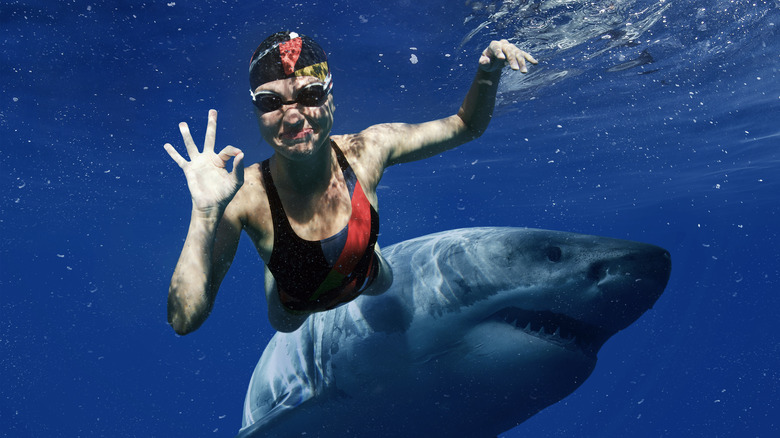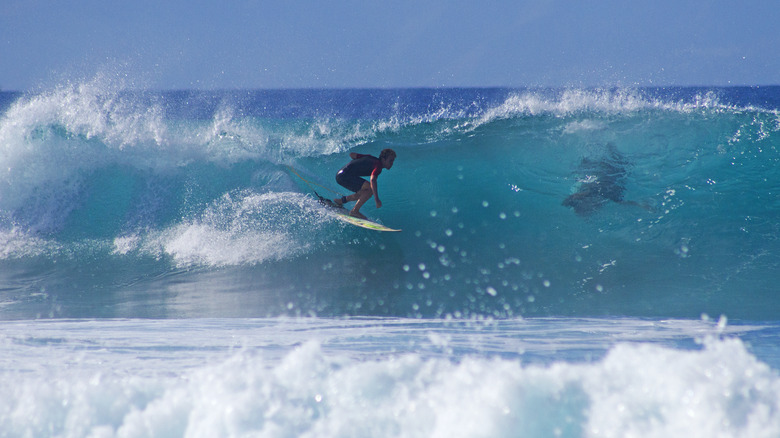Tips To Protect Yourself From Sharks While Swimming At The Beach
For most of human history, shark attacks weren't really something people worried about. Swimming in the sea wouldn't become popular until the 19th century, and most people who bathed in the ocean didn't know about sharks. Back then, even scientists knew very little about the creatures in their natural habitat. Shark awareness only started creeping into the public consciousness around the 1960s.
Then, in the '70s, Peter Benchley's best-selling novel "Jaws" became a summer blockbuster movie by Steven Spielberg. The movie thrilled and terrified audiences in equal measure and made Spielberg a household name. It was so successful, it kick-started a shark mania that resulted in trophy-hunting and contributed to severe overfishing, causing some species to become endangered.
Both Benchley and Spielberg have expressed regret about the negative impact their giant great white had on sharks in general. Fear of killer sharks has been overhyped by the media, not to mention by sequels like "Jaws 2" with its classic tagline: "Just when you thought it was safe to go back in the water." Decades later, understanding and appreciation of the creatures have improved, but the impact on Spielberg's movie lives on. Even so, real-life shark attacks are extremely rare: Each year, there are around 70 reported shark attacks in the world on average, and only about five of those result in death. While the odds are extremely low, there are a few things to keep in mind about sharks while swimming in the ocean.
Before you enter the water
Although the odds are low, the only surefire way to avoid an unwanted confrontation with a shark is to stay out of the ocean. While attacks have occurred in the chilly waters around Britain, they tend to happen more in the shark-infested waters of warmer climates. In the U.S., Florida and California have suffered more shark attacks than any other state, while the oceans around Australia are home to many species, including the dreaded great white.
If you're worried about sharks, you can take precautions before you even enter the water. It's advised to swim only where lifeguards are on patrol, as they will usually be on the lookout for sharks and can provide assistance if you are unfortunate enough to be bitten by one. Beaches in shark-infested locations will sometimes come with safety measures ranging from shark nets to hi-tech solutions like electromagnetic deterrents.
It's worth taking note of other factors before you swim. Are there any fishing boats operating in the area? This might mean morsels of food, chunks of fish, or blood in the water, all of which can entice a shark to come cruising for a snack. Also, keep an eye out for diving seabirds or smaller fish jumping out of the sea. The birds might be a sign of smaller creatures that can attract predators, and leaping fish might be a sign that a shark is hunting nearby.
Other factors to consider before swimming
If movies have taught us anything, it's that people love skinny-dipping in the ocean at night. The opening scene of "Jaws" successfully demonstrated that this is a bad idea if you are trying to minimize the risk of a shark attack. They are more active hunters in low light, and it is best to avoid swimming at dawn, dusk, or at night.
Also, be wary of murky water where sharks might mistake you for their regular food. This can result in hit-and-run incidents where a shark will take a bite, realize it got the wrong kind of prey, and immediately vacate the area. Murky water, particularly in places like estuaries where silt and other stuff gets churned up, is a favorite hunting ground for bull sharks, one of the species (along with the tiger and great white sharks) that are most likely to attack humans.
Other areas to use caution are channels of deeper water between the shore and sandbars, as well as steep drop-offs where sharks often like to patrol for food. These underwater details might not be immediately obvious from the beach, so it might be worth having a chat with a lifeguard if you are concerned. They will know the danger areas as well as the species of shark that might frequent the waters.
Once you're in the water
Most of us at one time or another have probably had the menacing tune of "Jaws" playing in our heads while swimming in the sea. Steven Spielberg's masterstroke was keeping the shark mostly offscreen, playing on our primal fear of something deadly lurking in the depths. In moments like these, however, it's good to remember that humans are not the first choice on a shark's menu. They're far more into seals or sea lions, which have a higher fat content to provide them with the nutrition they need.
The problem is that humans on the surface, especially while paddling on a surfboard or inflatable, can be mistaken for a nice juicy seal. As a result, 51% of shark attacks involve surfers or other board sports. The good news is that there are precautions you can take in the water to limit the risk of an attack. It's always a good idea to swim with other people, whether it is with friends or where there are plenty of other swimmers. There is safety in numbers because sharks are more likely to approach an isolated swimmer.
Although it is nice to get further away from the shore, you should avoid venturing into deeper water. Despite the often-quoted figure that most shark attacks occur in three feet of water (a popular statistic thanks to "Jaws"), the majority of incidents involving swimmers actually happen between six and ten feet.
Things that can attract a shark
Aside from bearing a passing resemblance to a seal, there are other things humans do that inadvertently attract sharks. Most of us have heard that sharks have an acute sense of smell and can detect a tiny drop of blood from a quarter of a mile away, but that figure is distorted because it can take time for the scent to reach them in the open water and doesn't take into account factors like ocean currents. Even if a shark does catch a whiff, it still doesn't mean it will make a beeline for you like Bruce in "Finding Nemo." Nevertheless, it is still advisable to stay out of the water if you're bleeding. While there is little evidence to suggest that menstruation increases the chances of an attack for women, sharks are known to be attracted to bodily fluids.
Another well-known cautionary tactic is to avoid too much splashing, especially in one spot. Sharks can detect the sound and come to see if there is a fish or other prey in distress. In the same vein, it's best to keep pets out of the water because their unpredictable movements can also draw a shark's attention. Another factor to consider is that shiny jewelry can resemble the flash of fish scales. Since sharks can distinguish contrast particularly well, uneven tans or brightly colored bathing suits may catch their eye.
What to do if you're attacked by a shark
Shark attacks are on the rise due to factors including climate change and more people in the water, but the chance of one occurring is still incredibly small. If you do find yourself face-to-face with a shark, there are a few things you can do.
This should be obvious, but don't mess with nearby sharks. People are sometimes compelled to get too close, from swimming with the animals to trying to feed them. These interactions can result in provoked bites, especially if food is involved.
If you find yourself in the water with a circling shark, stay calm and don't splash. You're not going to outswim a shark, and it is likely to chase you if you try. Your safest option is to vacate the water slowly while maintaining eye contact; sharks are ambush predators, and you should let it know that you are watching.
Sharks often feel their prey with their mouths to decide whether it's a good meal or not. Humans are usually spat out, but sometimes not before they're dragged under or bleed to death from the bite. If you are unfortunate enough to get bitten, the best method is to give the shark a fight. Punching it on the nose is often cited as the right tactic, but be wary because there's a big mouth full of lethal teeth just underneath. A better bet is to strike at its gills or gouge the eyes.





